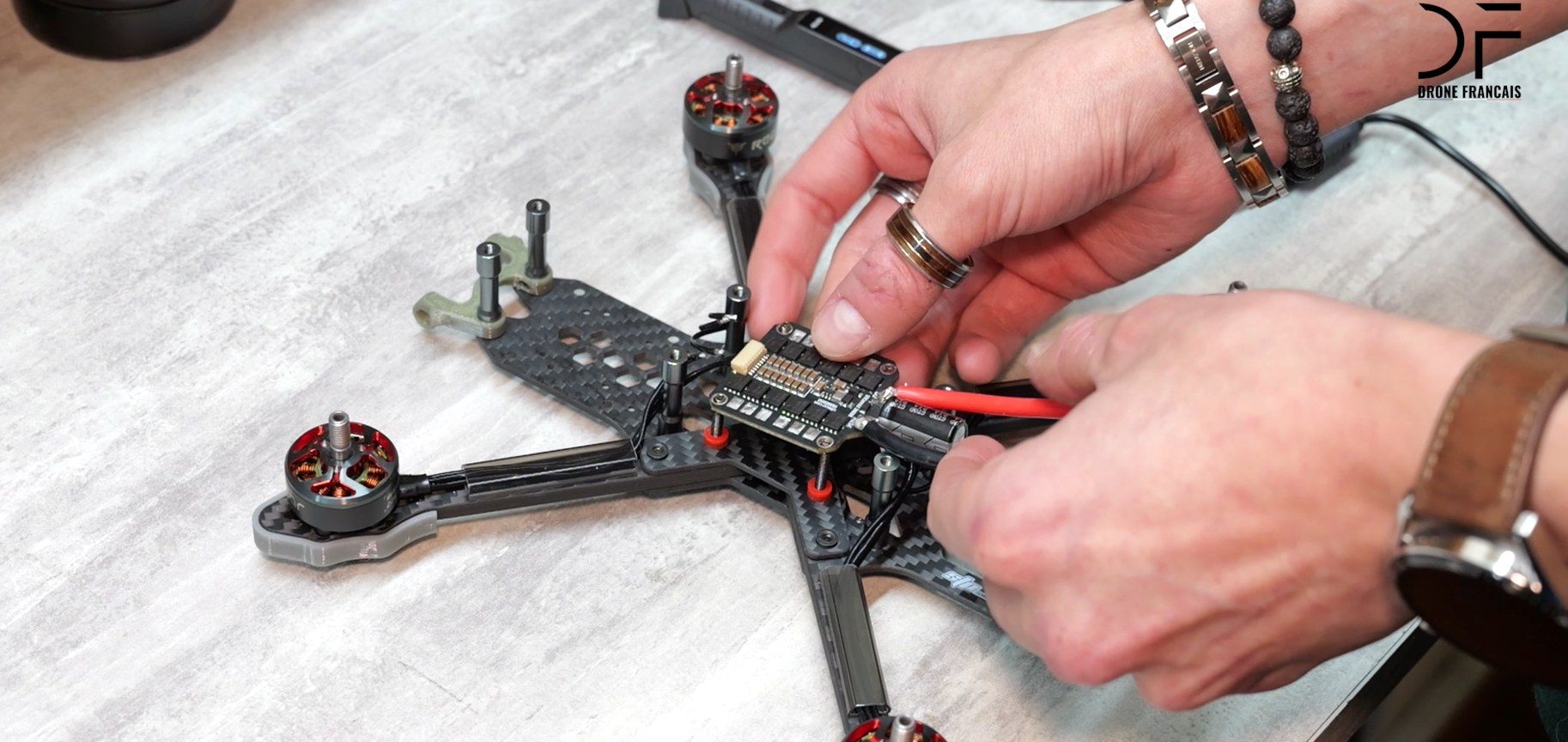FPV (First Person View) drones are revolutionizing the world of model flying by offering a unique immersive experience. Thanks to real-time video transmission, pilots can see exactly what their drone sees, as if they were on board. Whether for racing, freestyle, long-range or cinematic capture, FPV drones are winning over a growing number of enthusiasts.
Assembling your own FPV drone allows you to obtain a device perfectly adapted to your needs, with quality components selected according to your preferences. Unlike pre-assembled drones on the market, a DIY drone offers an unrivalled level of customization and a better understanding of how it works. Drone Françaisexpert in electronic components for drones made in France, offers top-of-the-range parts to design a high-performance, reliable FPV drone.
In this guide, we explain why you should build your own FPV drone, which components to choose and how to assemble your device step by step.
Why build your own FPV drone?
Buying a ready-to-use FPV drone may seem simpler, but building your own model has many advantages:
- Customization : you choose each component according to your needs.
- Performance : A DIY drone can be optimized for speed, range or video capture.
- Economy : Custom assembly can be more cost-effective than a high-end, pre-assembled drone.
- Technical understanding : building your own drone helps you understand how it works, and makes repairs easier.
Depending on your use, you can optimize your drone for :
- Racing : maximum speed and responsiveness.
- Freestyle : Stability and agility to perform tricks.
- The long range : improved range and autonomy for long-distance flights.
- Cinematography : Fluid capture with exceptional video quality.
Thanks to components from Drone Françaiscomponents, you can be sure of choosing parts that are robust, high-performance and compatible with today's FPV standards.
The essential components of an FPV drone
An FPV drone is made up of several key components, each with a specific role to play in the device's performance.
Chassis
The chassis must be light, robust and well-balanced. Carbon fiber is the material of choice, offering excellent impact resistance while remaining lightweight.
Motors and ESC
Brushless motors are essential in FPV for their energy efficiency and responsiveness. They must be coupled with ESCs (Electronic Speed Controllers), which regulate motor speed. See Centurion ESCs from Drone Français guarantee smooth power transmission with ultra-precise control.
Flight Controller
The flight controller is the drone's brain. It interprets the pilot's commands and adjusts stability in real time. The Abell flight card from Drone Français is ideal for advanced management, compatible with Betaflight and other firmware.
Radio receiver and remote control
A good receiver guarantees a stable, responsive link between drone and pilot. The Andromeda radio control system from Drone Français offers extended range and low latency, essential for submerged flight.
FPV system
The FPV system includes :
- An FPV camera on the front of the drone, with low latency and good image quality.
- A video transmitter (VTX), which transmits the stream in real time to a receiver.
- An FPV helmet or goggles to display the live image.
Battery and power supply
LiPo (Lithium Polymer) batteries are the most widely used in FPV, offering power levels adapted to the number of cells (3S to 6S).
FPV drone assembly steps
-
Frame assembly
Assemble the drone arms and attach the carbon plates. Install the camera support and check that everything is properly aligned.
-
Motor and ESC installation
Attach the brushless motors to the drone arms. Then solder the motor wires to the Centurion ESCs and check that they are working properly with a continuity test.
-
Attaching and connecting the flight card
Install the Abell flight card on shock-absorbing pads to reduce vibrations. Connect the ESCs to the board via the dedicated outputs and check the connections in Betaflight Configurator.
-
FPV system integration
Mount the FPV camera on the front of the drone and connect it to the VTX. Adjust the transmission power and choose a suitable frequency to avoid interference.
-
Radio receiver installation
Attach and solder the radio receiver, then connect it to the Andromeda.
-
Battery installation
Secure the battery with a strap and connect it to the board via an XT60 or XT30 connector.
Configuration and first flights
Configuration via Betaflight
- Flash the flight card firmware.
- Calibrate sensors (accelerometer and gyroscope).
- Set flight modes (Acro, Angle, Horizon).
- Adjust PIDs for better control.
Test and first take-offs
- Check engines without propellers before the first flight.
- Hover to adjust stability.
- Correct vibrations or oscillations via Betaflight.
Why choose Drone Français components?
Drone Français designs and manufactures specialized electronic components for FPV :
- Abell flight charts Advanced stability and compatibility with Betaflight.
- ESC Centurion Excellent energy management and enhanced reliability.
- Andromeda remote control Low latency and secure transmission.
By choosing Drone Françaisyou benefit from national know-how and innovative, high-performance, robust products.
Assembling an FPV drone is an exciting challenge, and the result is a 100% customized device perfectly suited to your needs. Thanks to quality components from Drone Françaisquality components, it's possible to design a reliable, high-performance drone, optimized for racing, freestyle or filming.
Whether you're an experienced pilot or a beginner, building your own FPV drone guarantees an immersive and rewarding experience. So, are you ready to take off?
